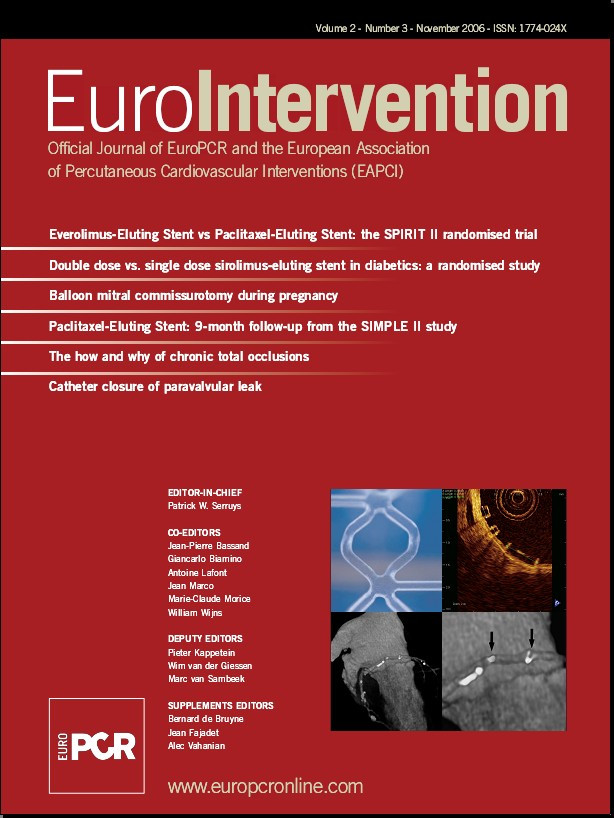A great war is raging whether a patent foramen ovale (PFO) should be closed after an event suggestive of paradoxical embolism. A smaller war is raging whether echocardiographic intraoperative guidance is necessary. The case report I am commenting on here pertains to both these issues1.
In a 42-year-old woman, a 35 mm Amplatzer PFO Occluder was implanted because of recurrent transient ischaemic attacks under guidance with echocardiography. A large device had been chosen because of an additional atrial septal defect (ASD) seen during either preliminary or intraoperative transoesophageal echocardiography (TOE). The procedure was considered successful. Before discharge mild chest pain and palpitations occurred but routine examinations including a transthoracic echocardiography and an electrocardiogram showed normal findings. A month later the patient complained about chest pain during exercise which was reproducible during a stress test that showed no electrocardiographic abnormalities. A coronary angiogram was performed and documented delayed clearance of the coronary sinus due to device obstruction of its mouth into the right atrium. It was decided to follow the natural course, but symptoms deteriorated over the following 5 months. At that time, a second opinion was obtained and the device was surgically explanted. Intra-operatively, the subtotal obstruction of the coronary sinus by the Amplatzer device was confirmed.
Worldwide, about 30,000 PFOs have been closed using Amplatzer devices. This is the first report of an obstruction of the coronary sinus, but which does not exclude other unreported cases. What is particular about this case?
First, the largest Amplatzer PFO Occluder (35 mm right atrial disk) had been used because an adjacent ASD had been detected. This raises the question about whether the device had been implanted into this ASD (or an additional undocumented ASD) rather than the PFO. The pictures provided do not exclude that. If a picture was available showing the device in perfect profile, it could be determined whether the Pacman sign2 was present. The Pacman sign refers to the V-shaped position of the two disks resembling the jaws of the video arcade figure Pacman biting into the wedge-like septum secundum towards the cranioventral direction. The absence of the Pacman sign suggests either a partial embolisation of the right disk into the left atrium, or a placement of the device in an ASD at a certain distance of the PFO. ASDs can be anywhere in the septum secundum, hence also close to the coronary sinus. However, occlusion of the coronary sinus has not been reported as a complication of about 30,000 ASD closures with Amplatzer devices, either.
Second, the patient who was awake during the procedure felt some discomfort for the first time during early follow-up, but the discomfort disappeared and subsequently reappeared only during exercise. One would expect the symptoms to be either unabating at rest, occur exclusively during exercise, or show an acute exacerbation in case of thrombosis of the coronary sinus. The degree of mechanical obstruction of the device itself should not alter. At surgery, there was no thrombosis but only mechanical obstruction of the coronary sinus.
Third, TOE performed during intervention either overlooked the problem or is not capable of diagnosing the problem. If the additional ASD was only detected by TOE during the intervention, the TOE itself has to be considered the source of the problem. The additional ASD prompted the selection of the large device. Had a smaller device been employed (the next smaller device has a 5mm shorter disk radius which would not have impaired coronary sinus outflow), the problem would not have occurred. A possibly persisting small ASD would not have been clinically significant.
The insight from this case confirms that with any procedure complications that are conceivable will eventually materialise. Yet, a reported incidence of 1 in 30,000 is hardly a reason to disqualify the procedure. The complication consisted exclusively of discomfort. No irreversible damage occurred. It can be argued that the necessity of heart surgery is a grave complication. On the other hand, PFOs have been, and still are, closed electively by surgeons for the indications present in this patient. Moreover, the coronary sinus could have been freed by implantation of a stent into its exit, keeping the Amplatzer Occluder out of the way and obviating the need for a surgical device explantation. While it cannot be concluded from this case that TOE should not be done during PFO closure, a necessity for this additional guidance can hardly be derived either. The TOE had completely failed its intended role of a chaperone.
The case report adds a further possible problem to look out for if patients report symptoms after PFO closure to the ones already known such as: embolisation of the device, atrial arrhythmia, puncture site problems, erosion of a free atrial wall3, or infection of the device. It also provides an argument to perform incidental coronary angiography after, rather than before, device closure when deemed feasible to simultaneously rule out, confirm, or treat coronary artery disease.

